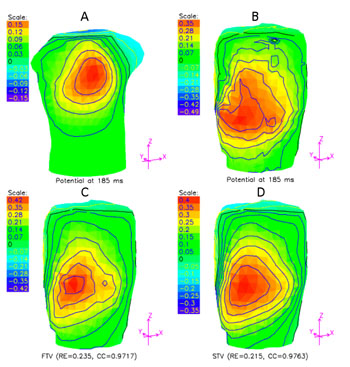Evaluation of Inverse Solution Approaches
Rok Hren, PhD
Institute of Mathematics, Physics and Mechanics, University of Ljubljana, Slovenia.Background
 |
| Sample results from comparison of inverse methods at 5 ms after the onset of the Q wave. (A) Torso potentials computed from the measured cylindrical cage potentials using boundary element method (BEM). (B) Measured cylindrical cage potentials. (C) Inversely computed cylindrical cage potentials using the totals variation method with (FTV) and without (D) the Laplacian regularization (STV). |
The goal of the project to date has been to evaluate systematically the performance of different regularization techniques using a realistic human torso model. We wish to compare also the boundary element method (BEM) and finite element method (FEM), two predominant methodologies in computing the geometrical and electrical properties of the torso volume conductor.
Goals
During the past 30 years, many research efforts have been devoted to exploring and validating the utility of electrocardiographic imaging, where potential distribution on the epicardial surface is inversely computed from a large number of electrocardiograms measured both on the anterior and posterior torso surface. Given that the electrocardiography community has developed a plethora of regularization techniques to tackle the ill-posedness and to gauge the rapidly oscillating inverse solutions, there is a growing need to compare, structure and unify those diversified regularization methods by using the same volume conductor and the same cardiac source models.The figure shows a small sample of the results from the study in which we compared two of the most promising approaches of computing epicardial potentials from a cage of electrodes surrounding an isolated canine heart in a torso shaped electrolytic tank. The simulation was carried out by the BEM, and the cage potentials were inversely computed by the FTV and STV. The body-surface potentials exhibited initial anterior maximum, resulting from the septal activation of the left ventricle. Both FTV and STV captured well the qualitative features of the cage potentials, with STV providing smoother solutions.
The specific aims of this collaboration are as follows:
- Expand the scope of the test data for use in the evaluation of numerical techniques.
- Use the results of these tests to motivate additional experiments and provide more data for validation within this and other collaborations or user studies.
- Incorporate the most successful inverse solution approaches into SCIRun and evaluate their effectiveness in a range of experimental and clinical settings.
